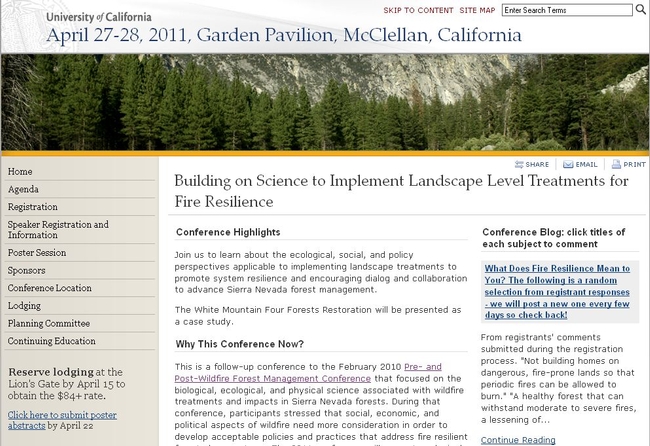May 13, 2011
I attended the “Wildfire 2” (AKA Building on Science to Implement Landscape Level Treatments for Fire Resilience) conference in McClellan last week. The conference, organized by UC Cooperative Extension and the Forest Service, was a follow-up to the Pre- and Post-Wildfire Forest Management Conference held in February 2010. Wildfire 2 built on the foundations of knowledge presented at the first conference and aimed to look at some of the broader social sustainability impacts of collaboratively based forest management.

A highlight of the second day was a panel discussion involving some of the key partners in the Dinkey Creek Collaborative Forest Landscape Restoration Program (CFLRP) project on Sierra National Forest. In 2007, part of the Dinkey Creek area was slated to be a timber sale (that never happened). The broad collaborative process regarding what a redesigned project might look like took place during 2009 and they won the CFLRP process in 2010.
Larry Duysen of Sierra Forest Products (SFP) gave a description of his family’s business in Terra Bella. SFP was established in 1968, among 8 sawmills, that drew sawlogs from Sierra and Sequoia National Forests. In 1988 the first litigation on a Sequoia National Forest timber sale signaled the beginning of the end for most of the sawmills in the southern Sierra Nevada. The sawmills were trapped between the Forest Service and the environmental organizations. SFP is now the only remaining sawmill and has lost 120 of its original 250 employees.

Sierra Forest Products, Terra Bella, CA
Sierra Forest Products, Terra Bella, CA
Craig Thomas of Sierra Forest Legacy, one of the organizations behind some of the litigation, described how he concluded that after 15 years of argument and fighting that no one was benefiting from the constant court battles. He reached out to senior managers in the Forest Service and they agreed to work together to bring the science community in to develop principles for forest ecosystem management based on sound science. This led to the publication of GTR-220: An ecosystem management strategy for Sierran mixed-conifer forests. More importantly, he started a constructive dialogue with the Duysen family to try to understand their business needs and to identify areas of agreement with respect to forest management.
As the collaborative process was broadened to include a greater number of groups and individuals, Gina Bartlett, of Sacramento State University Center for Collaborative Policy, was brought in to facilitate. It was challenging but progress was made as trust developed. At the start of the process very few of the people involved would consider working cooperatively with each other (16%) or trusted each other (9%). At the end of the process trust was complete and all were working cooperatively to submit the CFLRP application. Effective facilitation was essential to meditate and to ensure that all views were fully represented in the process.
Mose Jones-Yellin is the project coordinator for Sierra National Forest. As a Forest Service employee he values the fact that the collaboration gives legitimacy to land management decisions.
The main elements of success were identified as joint fact finding (including receiving technical assistance from scientists in order to inform decisions and site visits) and developing trust between the partners.
For me the progress made at Dinkey Creek gives cause for optimism for the progression to sensible, consensus based public forest management in California that delivers a wide range of benefits to communities, wildlife and the economy.
The presentations will be posted on the conference website shortly.
To view the original blog post on the Woody Biomass Blog posted on May 2, 2011, please visit: http://ucanr.org/blogs/blogcore/postdetail.cfm?postnum=4774.